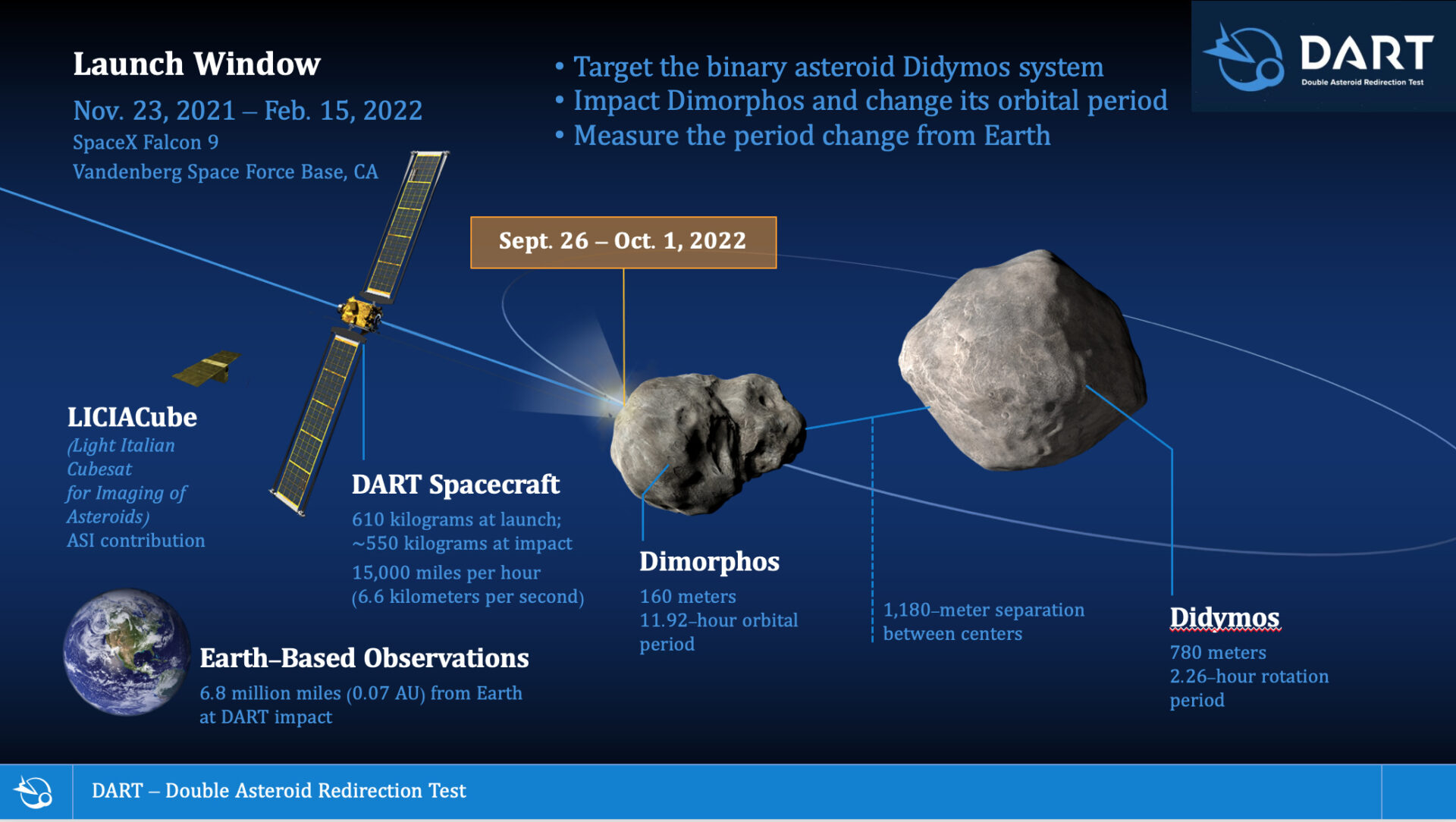
via Weizmann Institute of Science
NASA’s latest launch into outer space is going to make an impact. In fact, that’s its entire mission.
DART (Double Asteroid Redirection Test), which is scheduled to launch at 10:20 p.m. PST on Nov. 23 out of Vandenberg Air Force Base in California, is NASA’s first planetary defense mission. This mission will demonstrate asteroid deflection via kinetic impact. The goal is to collide with the target to see how the orbit changes. It’s a test run to see if such a plan is feasible should we find an asteroid on a collision course with Earth one day.
Cristina Thomas, an assistant professor of astronomy and planetary sciences at Northern Arizona University and lead of the DART Observations Working Group, is excited to see the effects of the impact. She and her international team have been working for years to obtain a precise pre-impact orbit of Dimorphos, the satellite asteroid, around Didymos, the primary asteroid in a near-Earth asteroid system.
Near-Earth, of course, is relative; the planet is in no danger from Didymos. However, an asteroid heading toward Earth is possible, and scientists throughout the world are working on ways to identify these potential threats and how to mitigate them. If this mission goes according to plan, this technique, called kinetic impact deflection, could be an important piece of a planetary defense system.
“DART is a critical next step for planetary defense,” Thomas said. “It is, on the surface, a simple test, but we will not completely understand what will happen until we do it.”
Using data from 2003, when the satellite was discovered, through early 2021, the working group has been able to precisely constrain the characteristics of the orbit and the position of Dimorphos in the orbit at the time of impact in fall 2022. They take repeated images of the same object, which shows dips in brightness when the satellite passes in?front of or behind the primary. The timing of these brightness dips, called mutual events, allows the scientists to determine the orbital period of the satellite.
“This is essentially thinking of the satellite Dimorphos as a clock, which will return to its position in front of or behind Didymos at consistent intervals,” Thomas said. “Our working group will begin observations again in the months prior to the DART impact. We want to have the most complete picture of the current orbit before we change it through impact.”
Thomas will be in California for the launch, and she and her team will continue to do observations after the collision to determine the change in the orbital period caused by the spacecraft’s impact. Follow her on Twitter at @cathomas09 for live tweets leading up to the launch.
What is DART?
NASA’s Double Asteroid Redirection Test is the world’s first full-scale planetary defense test, demonstrating one method of asteroid deflection technology. DART is a focused mission, proving that a spacecraft can autonomously navigate to a target asteroid and intentionally collide with it (called a kinetic impact) at roughly 4 miles per second (6 kilometers per second). Its target is the asteroid moonlet Dimorphos (Greek for “two forms”), which orbits a larger asteroid named Didymos (Greek for “twin”). As part of NASA’s larger planetary defense strategy, DART will simultaneously test new technologies and provide important data to enhance modeling and predictive capabilities and help scientists better prepare for an asteroid that might pose a threat to Earth, should one be discovered.
Original Article: DART launch could be key step forward in planetary defense
More from: Northern Arizona University | NASA
The Latest Updates from Bing News & Google News
Go deeper with Bing News on:
Double Asteroid Redirection Test
- Psyche spacecraft sends data back to Earth using lasers for the first time
NASA's experimental laser communication system, riding along with the Psyche spacecraft, has transmitted Psyche data from over 140 million miles away.
- NICK STROBEL: Lyrid meteor shower peaks tonight
We're now in the home stretch for spring semester at Bakersfield College. Just two weeks to go before we reach final exams week. The William M. Thomas Planetarium gave its ...
- NASA says 280-foot asteroid set to approach Earth! Know how close it will get
And now, US space agency NASA says that one asteroid that is as big as 280 feet is all set to get very close to Earth tomorrow, April 21. This makes it as big as a building. Just imagine what will ...
- Mess Created By NASA Will Be Inspected By ESA's Hera Mission; Here's All About It
Dimorphos gained international attention when it became the subject of NASA's Double Asteroid Redirection Test (DART) mission. On September 26, 2022, NASA's spacecraft intentionally collided with ...
- Asteroid debris from NASA's successful DART mission may strike Mars
DART mission successfully deflected an asteroid's path by deliberately colliding with it, but Mars may suffer unintended consequences.
Go deeper with Google Headlines on:
Double Asteroid Redirection Test
[google_news title=”” keyword=”Double Asteroid Redirection Test” num_posts=”5″ blurb_length=”0″ show_thumb=”left”]
Go deeper with Bing News on:
Planetary defense
- Hera asteroid mission's side-trip to Mars
ESA's Hera asteroid mission for planetary defense will make a swingby of Mars next March, borrowing speed to help reach its target Didymos binary asteroid system.
- Planetary Sciences news
ESA's Hera asteroid mission for planetary defense will make a swingby of Mars next March, borrowing speed to help reach its target Didymos binary asteroid system. A critical NASA mission in the ...
- Earth's weird 'quasi-moon' Kamo'oalewa is a fragment blasted out of big moon crater
Scientists turned into cosmic crime scene investigators to reconstruct the impact that sent Earth's "quasi-moon" Kamo'oalewa rocketing from the lunar surface millions of years ago.
- Helldivers 2 multi-planet liberation isn’t working as intended yet
The Helldivers 2 Martale gambit is part of a larger system in Arrowhead's game, where planets could be automatically liberated as we fight.
- European Space Agency set to launch probes at asteroid to test planetary defense system
The Hera mission will study the Dimorphos asteroid that was pushed off course by NASA’s DART spacecraft in 2022 ...
Go deeper with Google Headlines on:
Planetary defense
[google_news title=”” keyword=”planetary defense” num_posts=”5″ blurb_length=”0″ show_thumb=”left”]










